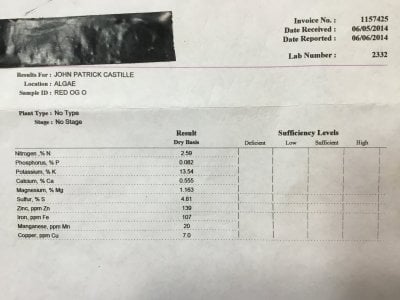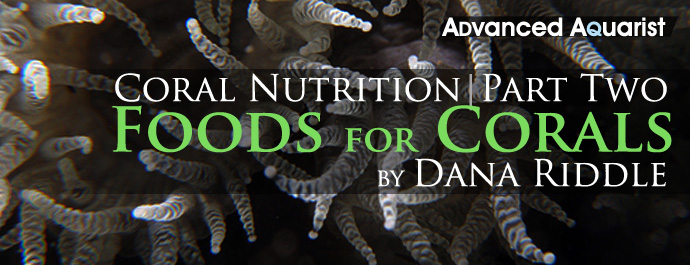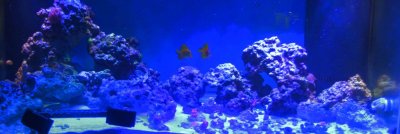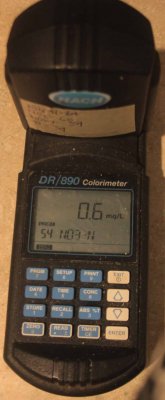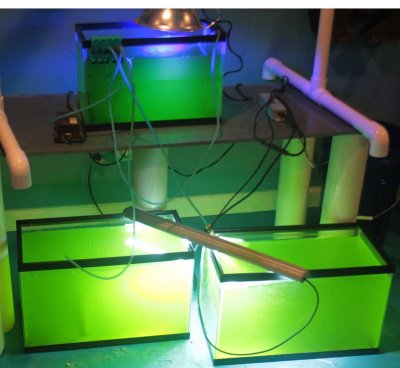- Joined
- Jan 6, 2017
- Messages
- 2,325
- Reaction score
- 2,293
What a beautiful write up. Well though out and valuable especially for new reefers. Thank you for sharing.Skip ahead to the last two sentences if you have a short attention span.
I've seen a huge number of things come and go in this hobby and fall in and out of favor. Most of them are relatively harmless and just leave the aquarist out some money, nearly every single element that people dose outside the big three could full under these. Potassium, strontium, molybdenum, "trace elements", amino acids. All superfluous and relatively harmless to dose.
In the early days of carbon dosing some people started doing so without even realizing it by dosing vitamin C, and prior to that there were some people playing around with vodka and a little later VSV. It could yield some great results in tanks that had elevated nutrient levels, at least in the short term. In the long term it often led to people with "burnt tips" pale corals and corals suffering from phosphorous and nitrogen being too low. Then people started dosing amino acids and seeing some corals color up, likely because they were acting as a nitrogen source for a nitrogen starved coral, and likely not because the amino acids themselves are needed by the corals, or even utilized.
I was largely away from the hobby for some years due to a disastrous move and some lack of motivation to revamp my now mediocre reef. Now that I'm more active on the forums again it's really sad to see how many new aquarists are suggesting carbon dosing for people that have detectable levels, nitrates to maintain a certain level, or PO4 to maintain a certain level. All of these mess with the balance of natural bacterial populations and can be very harmful to corals if you don't understand the possible damage you can do by manipulating bacterial populations to unnaturally low levels and making certain corals deprived of a necessary nutrient. Now that supplement companies have made overpriced sugar a popular dosing additive it's far more widespread and potentially harmful than ever.
For anyone new that might read this, give your tank a good 6 months to stabilize, if your nitrates are elevated (25ish + ppm) and rising then get a bigger protein skimmer, consider handling food input differently and make sure all mechanical filtration is changed frequently. If they're low or non detectable and everything looks fine, maybe feed a little more or otherwise stay the course. If Acropora are looking pale, throwing out a lot of mesenterial filaments at feeding time, or have "burnt tips" then you should up your fish load and/or add an extra feeding in during the day, preferably something high protein like a good flake or pellet food, cutting down on skimming is another option to consider. Dosing nitrate if nitrate is too low will likely lead to driving phosphates too low and doing damage to corals, dosing phoshates when they're too low likely will lead to nitrogen being used up too quickly and not as readily available as needed for healthy coral growth.
Yes, some people have been able to find a balance with their manipulating of bacterial populations, but there are very few that are able to do so long term without having a lot of luck on their side. No one understands fully what's happening, but my speculation is that it's related to the redfield ratio and which is the ratio. The Redfield ratio is a relatively constant ratio of 1 that the biomass in the worlds oceans usedcarbon, nitrogen and phosphorous at a relatively constant ratio of 106:16:1. More recent studios have suggested a slightly different ratio of C:N163:22:1. The exact number doesn't matter for our needs, but what matters is that all are available in adequate supply in our aquariums, drive one of them too low and damage can be done, and that seems especially true with Acropora species.
I've always liked to experiment and am an early adopter or at least like trying new things and ways to do anything reef aquarium related. I went on a few wild rides with my tanks, first with vodka and carbon dosing, second with chasing a nitrate number, and finally chasing a phosphate number. Once I had been carbon dosing for some months it was clear that it was very difficult to control the bacterial populations, and that corals were losing out on nutrients. Cutting back the carbon dose wasn't helping, stopping the dose wasn't helping either, or at least not fast enough. I'm now not dosing My PO4 was usually between .05 and .12 using GFO intermittently , I couldn't find a trace of any nitrogen source, so I deduce that I need nitrogen and probably wrongly land on nitrate. Corals don't look bad at this point, they just look a little paler than I like (think SunnyX T5 tank). A few days later I start dosing and boosting nitrate to 5 ppm and find a weekly dose that drops close to non detectable before my next dose. My corals are starting to look pretty good again, especially my Montipora that got pale. For those still reading, this is a great canary coral, if your red/orange Montiporas looking pale, one of your nutrients is getting too low.
Some weeks pass and corals start to pale up again. I start testing nitrate more regularly and realize it's bottoming out in 3-4 days. I up the dose... I keep upping the dose and I find a rhythm, all is good! Corals look better, all algae is subsiding, I'm happy. I'm feeding tons of flake food, I have the fattest happiest convict tang ever seen. Little do I know, my phosphate has been creeping down this whole time. I tested one day with my Hanna PO4 Checker and get a reading of .04, I'm a little shocked, but corals look great.
A couple months pass and corals are starting to look rough, mesenterial filaments to the extreme every time I fed the tank, and it appeared to be a stress reaction, especially when flesh was very thin and coming off the tips of some corals, others very pale and pastel. At this point I'd had enough and decided to stop dosing, but the numbers weren't rising. I decided I was just going to keep adding fish and keeping them fat with lots of flake food until I could keep corals with deep rich colors. Some years later that tank using simple methods won tank of the month in Reefkeeping magazine and looked far more beautiful and grown in than those photos showed before it was torn down due to a move.
I'm not saying no one should carbon dose, or play around with nitrate and phosphate dosing. All I'm saying is that you'd better understand what's happening and not look at it like just any old bottle of mostly water supplement you could dump in your tank and not have it do much. You also had better have a keen eye for a slightly distressed coral, because if you don't, you won't see the potential damage until it's too late. These are thing that you can dose and do serious damage with, and the slow progression of corals getting better for a while after you start dosing makes a lot of aquarists think this stuff is just great. It's bad for the hobby because it fools many people into thinking their tank is improving, when there's a good chance they're heading down a slippery slope that will at least harm and impeded the growth of their prized corals.
This hobby would be in a much better place if people didn't chase numbers using liquids and would simply make adjustments via their fish load, feeding, and protein skimming. It's a delicate balance to find, but it's far more forgiving of the extremes of messing around with manipulating bacterial populations via overpriced sugar and water or some fertilizer and water. Most supplement companies are the modern day equivalent of snake oil salesmen. If they think they can convince you something makes a difference and is good for the aquariums we love, they know we will buy it. They don't care if passing off a bottle of sugar and RO water as some miracle nitrate and phosphate reducer means you'll eventually struggle to find the right balance of nutrients in your tank. They just want their $20 and hope you never attribute their product to the death of your Acropora and just think about how the product/system/method colored up their corals. Any of the companies that are selling this stuff and realize the harm it can cause should be ashamed of themselves. The ones that don't realize how damaging it can be shouldn't be selling it. The ones that barely put anything in their product other than water, you're also bad for the hobby, but at least you're not killing peoples corals with heavy carbon dosing?
I'm not a scientist, and my basis for this is my many years of experience and reading whatever I can about marine biology, corals and aquariums. This is something I believe to be true, so someone with a science background please school me on this if you can. I get the sense that a coral being nitrogen limited is something that it's pretty well adapted to, I believe it's the most common limiting factor if one considers the Redfield ratio. I believe phosphate is the one that would be a rare limiting factor for growth in nature, and that the tiny amount required for growth is often available in a variety of marine environment in abundance. It at least seems to lead to the possibility that corals do not do as well as they could, but can tolerate when low nitrogen is a limiting factor of growth. If you can somehow figure out a way to dose to get your phosphate so low that it's barely detectable (.02-.03ish), you're potentially going to do some damage, perhaps because Acropora are poorly adapted to being P starved. The damage that using granular ferric oxide and aluminum oxide too aggressively seems to support that belief. Lanthanum chloride users, probably don't see it as much since it doesn't seem to be capable of driving levels too low. However, is too rapidly, say a jump from .23 to .10 also damaging and possibly a difficult change to adapt to? Any coral biologists around?
Stop feeling the need to dump liquid in all the time, there are safer and better ways to solve your short term problems and have long term success! For anyone that made it this far, I'm sorry, and I commend you for putting up with my awful writing and punctuation for this long [emoji14]
Let me know if you think I'm off my rocker, or if you agree. Do you think carbon, nitrate, and phosphate dosing is bad for the hobby?
Completly agree with you, carbon dosing, phosphate and nitrate dosing has become something that led so many reefers to be in frustrating loop that often lead to bad ling term results.
Carbon dosing in my openion if done right works, but index on done right...
Thanks again for the write up








